Menu

Farm workers often get backaches and pains in their shoulders, arms, and hands. This happens more than any other health problem. It shows how important good posture is for those who work in farms. This is crucial for their health and how well they work. Farm workers do lots of stooping, carry heavy things oddly, and kneel a lot. These actions can cause injuries like sprains, strains, and bad back pain. This harms the workers’ health and the farm’s ability to make money.
Using proper ergonomic methods is key to dealing with these issues. It can really make farm work better. Fewer workers get hurt and the work environment is healthier. This means that people work better and the farms make more money. So, it’s great for both the workers and the farm owners. It’s important to spend on ergonomic tools and ways of working. It’s not just a choice but a must for keeping farm workers healthy.
Ergonomics is key to making work spaces better to boost efficiency and prevent harm. In farming, it’s vital to have the right posture. This is because farm work is often physically demanding and repetitive.
Ergonomics is about creating work places that keep workers safe and healthy. It means fitting tasks, tools, and work areas to the workers. This lowers the risk of getting hurt. For example, placing regularly used items close to you and using the right tool sizes can make work easier and less tiring.
Farm workers often suffer from back and upper body pain. This is due to tasks that need a lot of effort or are done in awkward positions, especially if they are done over and over. Setting up work areas at the right heights and using well-designed tools can help. This approach lessens pain and boosts farming productivity by keeping workers fit and strong.
| Problem | Ergonomic Solution | Impact on Productivity |
|---|---|---|
| Backaches | Proper workstation heights | Reduced fatigue |
| Shoulder Pains | Keeping items within 17 inches | Increased efficiency |
| Whole-body vibration | Vehicles with suspension seats | Enhanced comfort |
Opting for ergonomic solutions is good for both farming productivity and it’s cost-friendly too. These methods tackle the dangers of doing repetitive and strenuous tasks. They help build a farm working environment that is safer, healthier, and more productive.
Agricultural workers face many demands, leading to serious health issues. Most of these come from how they work, often causing injuries. These problems are quite common.
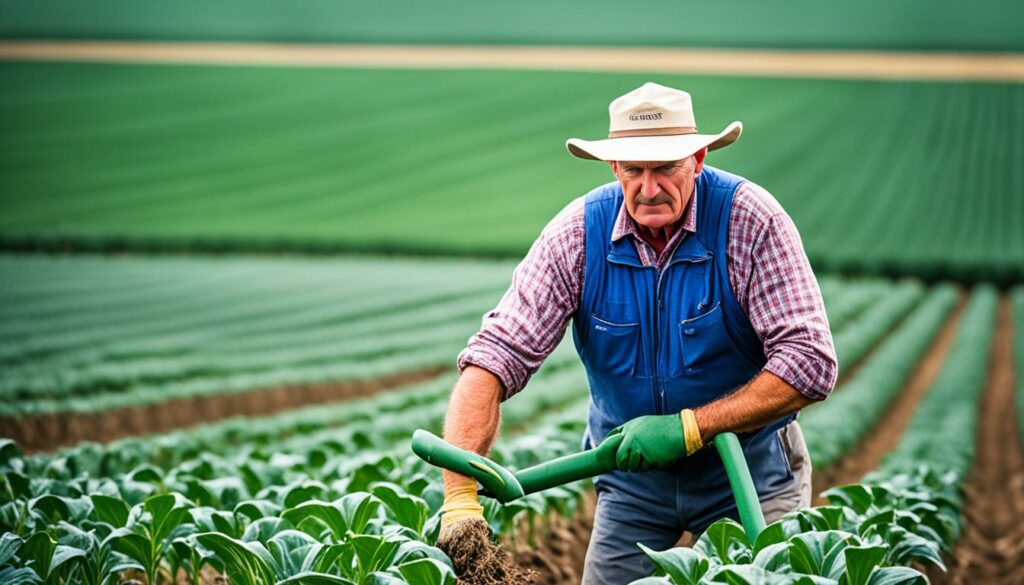
Backaches and pain in the shoulders, arms, and hands bother many farmworkers. About one in three injuries making them miss work are sprains and strains. Back injuries make up a quarter of these cases. These issues, known as work-related musculoskeletal disorders (WMSDs), can disable workers in their prime years.
In California, more than 3,000 back injuries happen in agriculture each year. This adds up to over $22 million in workers’ compensation. The main reasons for these injuries include bad posture, lifting heavy things the wrong way, and doing the same movements over and over.
It’s important to use smart ergonomics to prevent these injuries. Ergonomics means making work fit the worker better, making things safer, more comfortable, and more productive. By changing tools and how work is done, we can cut the risk of WMSDs a lot.
Table below provides a summarised overview of the common postural issues and their impacts.
| Injury Type | Percentage of Cases | Compensation Costs (California) |
|---|---|---|
| Sprains and Strains | 33% | — |
| Back Injuries | 25% | $22 million annually |
| WMSDs | — | — |
Changing how things are done and training workers on safety is key to avoiding injuries. Farm managers should look into using ergonomics to tackle these problems. Signs like a lot of pain, many injuries, or reports of feeling strained are warnings they should not ignore.
Keeping the right posture while working on the farm helps prevent injury in agriculture. Workers often complain of back, shoulder, arm, and hand pain. This is mostly because their jobs require lots of lifting, repeating the same actions, and having to move in strange ways. But, using ergonomic farming practices can cut these problems down a lot.
Checking how you stand and move during farm work is really important. Doing this often can point out where things are going wrong. It helps to fix how work is done to stop the physical strain, tiredness, and pain many workers feel because they’re not standing or moving right.
Making sure your tools are right for your hands is also a big deal. They should be easy to hold and not slip. Changing how you work based on ergonomic farming practices really lowers the chance of hurting your muscles and bones.
To really cut down on getting hurt, make changes to stand and move better, use less force, and don’t do the same things over and over. These steps help make farms safer and healthier places to work. They also help farms do better overall and can cut down on the money spent on helping hurt workers.
Working in awkward positions on farms is risky for farmers. It affects their health and how much they can work. These awkward positions often lead to body pain.
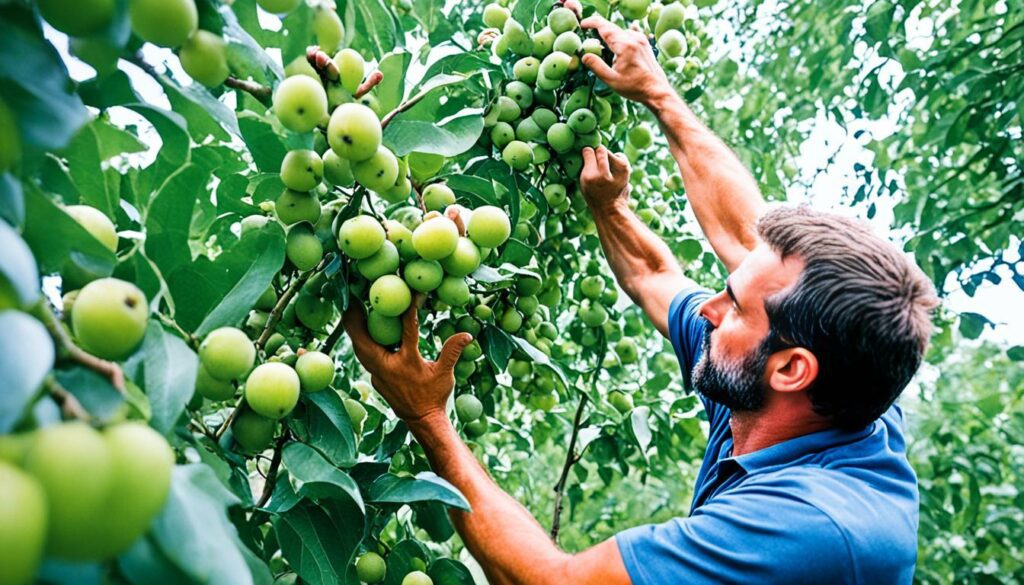
Farmers are often hurt by doing heavy work. This can include lifting heavy things and using machines that shake a lot. In California, for example, many Hispanic farm workers faced injuries because of these heavy tasks. In Southeast Spain, greenhouse workers also suffered a lot from body pain.
Farmers risk their health by doing the same movements over and over. This can lead to muscle and bone pain. For example, many get pain in their lower back. In Kansas, nearly half of all farmers reported having this problem.
In some cases, these body pains can become very serious. In China, for instance, thousands of farmers have suffered from damaged joints and severe body pains. This shows how important it is to avoid working in awkward positions.
To make work less painful, farmers can change their tasks often. This helps to avoid using the same muscles too much. It also gives the muscles time to get better.
Taking breaks and stretching is also very important. Giving time for farmers to relax their muscles can stop pain from starting. Using tools that reduce the roughness from machines helps too.
Even small changes can make a big difference. By moving work items or changing how tools are used, farmers can be more comfortable. This not only reduces pain but also makes work more efficient.
| Study Location | Injury Cases Reported |
|---|---|
| Kansas | 49% low back pain prevalence |
| Southeast Spain | 219-235 musculoskeletal disorder cases |
| California | 225-235 agricultural injuries |
| China | 1301-1310 degenerative lumbar osteoarthritis cases |
| Netherlands | 204-214 risk factor cases for sick leave due to musculoskeletal disorders |
Using ergonomic farming practices can greatly improve farm workers’ lives. Many suffer from backaches and pain in the arms, shoulders, and hands. This is usually because of tasks that involve bad postures and repetitive movements. Our aim is to find practical solutions to reduce these issues.
Work that requires using your hands a lot can cause problems like carpal tunnel syndrome. Ferrante (2016) found that holding tools for a long time is risky. To lessen this risk, tools should be designed with comfortable handles. They should also be the right height so workers don’t have to strain to reach them. The National Institute for Occupational Safety and Health (2001) suggests workbenches should be at a height where you can easily reach but not have to bend or stretch too much.
It’s vital to use hand tools correctly for farmers’ health. Meyers and his team (2006) discovered that making tools 11 pounds lighter can cut down on pain, and results in fewer symptoms. But, it only slightly lowers productivity. Hand tools should have easy-to-hold straight handles and be the right length for the job. Special tools make the work easier and prevent muscle problems.
It also helps to have tools with handles that match your hand size, measuring between 1-3/8″ to 2-1/8″. Doing this makes work easier on the hands. Better tools and work methods not only follow guidelines for hand work but also reduce common work injuries, like musculoskeletal disorders and back pain.
| Ergonomic Improvement | Impact | |
|---|---|---|
| Redesigning Tools | Reduces need for excessive force | Lowers risk of WMSDs |
| Optimal Handle Sizes | Improves grip comfort | Reduces hand strain |
| Reorganising Workstations | Positions tools within easy reach | Prevents excessive reaching |
| Weight Reduction in Tools | Decreases physical load | Reduces pain symptoms |
It’s key to include ergonomic farming techniques. By paying attention to how farmers hold tools and the design of their work areas, we can make farms safer and more productive.
Evaluating how people work in agriculture helps find and stop risky postures. The aim is to lower the chance of getting hurt, especially with musculoskeletal disorders. These are common among farm workers. It’s key to have workers check their own postures. This way, the process is more precise and helpful for them. It boosts their health and how much they get done.
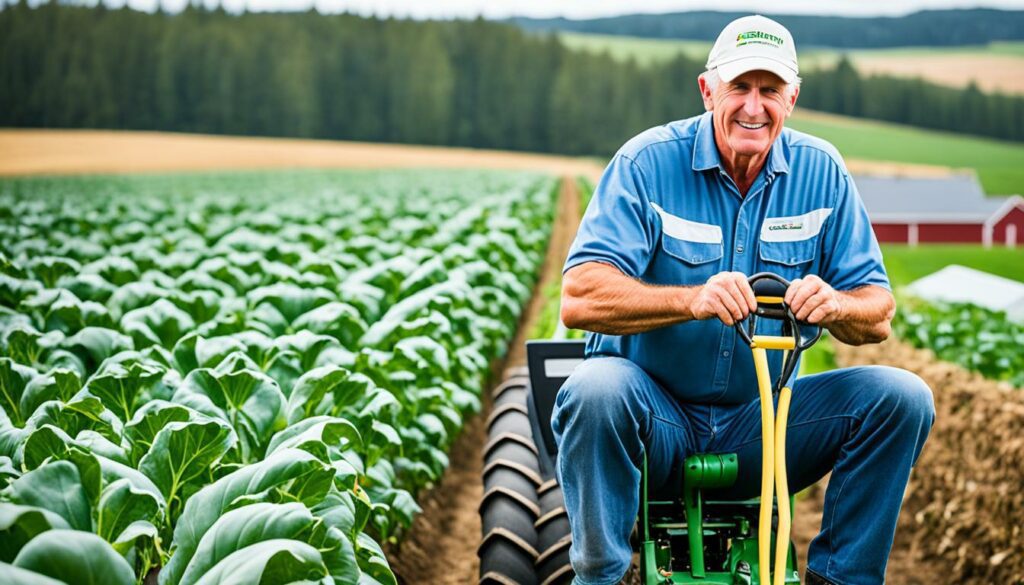
There are many tools to check how people sit or stand on farms. For example, there’s Rapid Upper Limb Assessment (RULA) and Rapid Entire Body Assessment (REBA). Also, there’s the Ovako Working Posture Analysis System (OWAS). The tool Agricultural Upper Limb Assessment (AULA) was made just for farming. It’s said to work better than others for this job. It reported 48.6% precision, which is better than RULA’s 33.3% or REBA’s 30.1%. AULA is great for looking at how people position their arms and upper bodies when working on a farm.
Getting the farmers to help with checking their postures is very important. They know best about the work and what’s hard for them. Working together like this helps find what needs to change for each job, be it shearing or driving machines. Research shows that when workers give their views, we find and fix posture issues better. This worker-focused method is key to making farms a safer and more effective place to work.
| Assessment Tool | Hit Rate | Kappa Value |
|---|---|---|
| AULA | 48.6% | 0.718 |
| RULA | 33.3% | 0.599 |
| REBA | 30.1% | 0.578 |
| OWAS | 34.4% | 0.538 |
Using proper body mechanics in farming is key for stopping injuries and doing work better. Farm workers often feel backaches and pain in their shoulders, arms, and hands. This shows we need to focus more on making farms safer.
Injuries that affect muscles and bones are the main reason for workers taking time off. Farmers face a high risk, with many suffering injuries such as sprains and strains. In California, over 3,000 back injuries in farming lead to costs over $22 million a year.
Changing the design of farming tools to fit better in our hands can really help. For example, using tools with longer handles can stop workers from bending a lot. Using lighter materials can also help workers feel less tired. This way, we aim to keep farm jobs safe, comfy, and efficient.
There are simple ways to improve how we work which can really help. Keeping tools in top condition and well-oiled can lessen injury risks. Also, changing the height when caring for animals can make the job easier on the body. With the right tools and methods, working on the farm can be healthier and easier.
In conclusion, focusing on how we work and preventing injuries can make farming more productive and safer. It ensures farm workers have less health risks and feel more comfortable.
Improving posture in farming needs a broad approach. This includes changing tools and work areas, and teaching good ergonomics. These methods can lower the number of farm workers who suffer from disorders. This will better their health and how well they work.

Changing tools and work areas is key for better farming postures. We look at each tool to see if it’s good for the body. We make changes to help workers not strain as much.
For example, tools with special handles can stop workers from holding them too hard. This often leads to health issues. The CDC shows that better work areas can cut down injuries. This helps keep farm workers from needing time off.
Training workers in ergonomics is another useful step. These programmes teach how to keep a good posture. They also show ways to do tasks without getting hurt.
Having workshops on ergonomics lets workers learn how to sit and move right. This can stop injuries. Workers also learn to spot when they’re starting to hurt, so they can fix it before it gets bad.
Just in California, back injuries cost over $22 million a year. This big cost is why it’s smart to use these ergonomic ideas. Combining better tools and teaching, we can make farming safer and last longer. This keeps farm workers healthy and working well.
Improving how you stand and move in farming mixes comfortable changes with staying safe. Each year, California spends more than $22 million on over 3,000 back injuries. This high cost shows why improving how we stand matters. It cuts down on injuries and makes farm jobs safer. Nearly a third of injuries keeping farm workers from work come from twisting things (sprains) and overstretching (strains). About a quarter are back injuries. This highlights how important it is to find better ways to do farm work.
Adjustments to workspaces can make farm work safer by picking the best ways to do tasks. This means looking at the tools we use, where we work, and what our bodies can do. For example, smaller tubs for picking grapes, closer rungs on ladders, and cutters that work without hands have all helped reduce hurt and stop injuries.
Tasks like weeding and cutting mean a lot of bending and doing the same movements over and over. Tools like hoes with long handles and carriers that reach farther make these jobs easier. They help us avoid bad body positions. Tips for lifting things say to keep the load close to our bodies and to use handles when we can. This lowers the chance of hurting our backs, which is a big problem in farming work.
Taking breaks from tasks that need a lot of bending can also help. This gives our bodies some time to recover and lowers the risk of getting hurt a lot. By looking at how we design tools and the steps we take to do jobs, we can make farming safer and more productive.
| Intervention | Outcome |
|---|---|
| Smaller tubs for harvesting grapes | Reduced back pain |
| Reduced space between orchard ladder rungs | Less strain in climbing |
| Pneumatically-powered cutters | Assisted workers with partial disabilities |
| Long-handled hoes | Diminished trunk flexion |
| Extended-handle carriers | Minimized awkward postures |
In the end, making working conditions better in farming not only improves our posture. It keeps us safer, which helps farms do better. This leads to a happier and more long-lasting farming world.
Technology has changed farming, making work easier and healthier for farmers. It has introduced new, efficient ways of doing things. These changes also help reduce the hard work done by farmers. We will look at how high-tech farm tools have made a difference. We’ll also talk about what the future might bring with exoskeletons and robots.
Farm tools have evolved to meet the needs of today’s farmers. This change is because of the use of modern technology. Farmers now have tools that are easier to use but work better. For example, from simple hand tools to complex machines, everything is designed to make work less tiring.
Research shows that using tools that match a person’s body can make farming safer. Tools like shovels and hoes come in different shapes and sizes. This lets workers pick what fits them best. Making tools more customised, like adding extra handles, can make them easier to use.
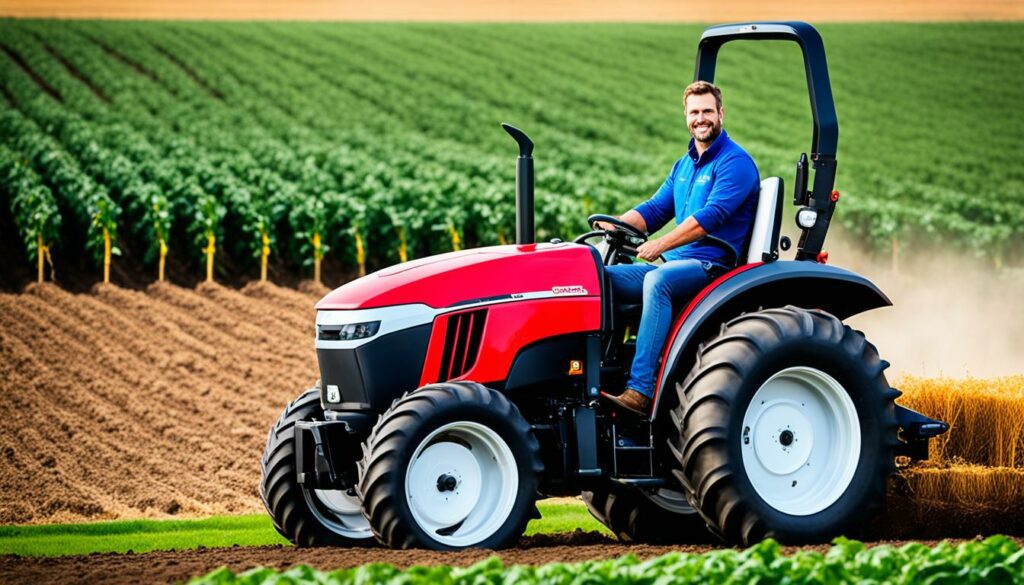
Looking forward, exoskeletons in farming show a lot of potential. These are wearable devices that boost what a human can do. They aim to make farm work less hard on the body. Exoskeletons help with lifting, staying stable, and lower the risk of body injuries.
Another exciting area is the use of robots in farming. These robots do jobs that are tough or dull for humans. They can work by themselves using smart sensors and AI. This means people can do more important jobs while these robots handle the hard work. Using these new technologies, farms can be more productive and keep their workers safe.
It’s crucial to keep a good posture to lower the risk of injuries for those working on farms. By adding certain activities to their daily schedule, workers can stay healthier and more productive.
Doing stretching exercises is key for farm workers. It helps keep their body strong and flexible. This means less pain in the shoulders, arms, and back, areas that often hurt.
Making everyday jobs on the farm easier and safer helps reduce injury. About a third of work injuries on farms are twists and pulls, and a quarter are back issues. Here’s how to make tasks safer:
| Risk Factors | Prevention Strategies | Outcome |
|---|---|---|
| Lifting objects over 50 pounds | Use mechanical aids, and adopt team lifting | Reduced back injuries, lower compensation claims |
| Poor sitting and standing posture | Regular ergonomic training and practice | Improved posture, fewer musculoskeletal disorders |
| Prolonged time in one position | Implementing hourly breaks and task variation | Enhanced comfort, reduced fatigue |
“`
This section uses important words like ‘maintaining optimal posture’ and ‘ergonomic daily routines’ throughout. This helps with search results and makes sure the information is useful and reliable for the readers.
Ergonomic solutions in farming are vital for keeping workers healthy. Backaches are very common, and many workers have to take time off because of sprains, strains, and back injuries. In California alone, over $22 million is spent each year on workers’ compensation for back injuries. This shows how important it is to protect workers’ health.
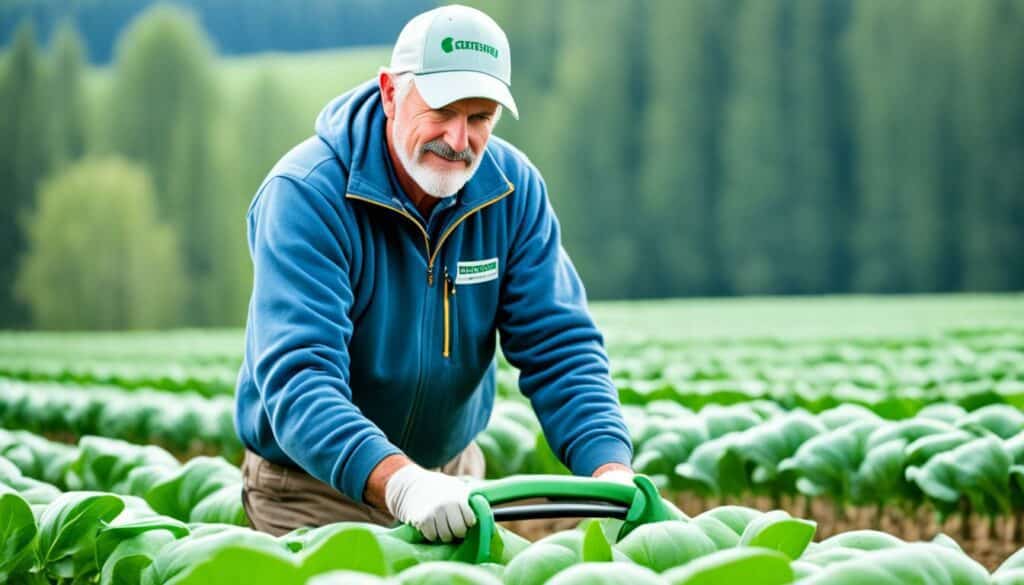
It’s important to find affordable ways to make farming safer. For example, using smaller tubs for picking grapes can cut down on back pain. Making the spaces between ladder rungs smaller can help reduce falls in orchards.
Long-handled hoes and carriers for potted plants are also great ideas. They help workers avoid bending over too much, improving both their health and efficiency. Tools like power cutters lessen the strain of repetitive cutting tasks.
Getting input from workers is crucial to making ergonomic changes work. They know best about the challenges they face. For instance, they can suggest taking more breaks to relieve stress from long periods of bending over.
Listening to workers when designing solutions makes them more likely to be used. This ensures the changes meet the real needs of farm life. So, it makes working on the farm safer and more comfortable.
Improving farm ergonomics helps workers and also saves money. It makes farms more productive and reduces the costs of injuries. By listening to workers and using smart, low-cost changes, farm safety and efficiency can be greatly improved.
| Statistical Data | Description |
|---|---|
| Backaches & Pain in Extremities (Most Common Symptoms) | Reported by farm workers |
| Sprains & Strains | Cause a third of injuries necessitating time off work |
| Back Injuries | Account for a quarter of all injuries |
| $22 Million | Yearly workers’ compensation costs for back injuries in California |
The farming sector faces special problems in preventing work-related musculoskeletal disorders (WMSDs). In California, over 3,000 back injuries happen every year. This costs the state’s agriculture over $22 million in workers’ compensation. One-third of the injuries that make workers take time off are sprains and strains. A quarter of the cases are back injuries, which are the main reasons for disability. So, it’s crucial to have clear plans to reduce these risks.
Doing work that includes gripping, lifting, squatting, bending, and using vibrating tools cause many WMSDs. Making changes to how things are done, like redesigning tools and how work is carried out, can improve posture and cut down on injuries. If work tasks are making people feel overly tired or in pain, it’s a sign that an ergonomics programme is needed. This programme would focus on reducing strain by changing how the work is done.
Research shows that ergonomic issues are a global concern. Places from Saudi Arabia to Bangladesh have looked at the effects of ergonomics on health. It can be challenging to introduce ergonomic solutions because some workers think pain is just a part of the job. But, changing work tools, the job itself, and building in rest times can help a lot. Offering tools that help keep a good posture and job rotations are two key ways to decrease WMSDs.
To face ergonomic issues in farming, we need to teach workers, use new technology, and get everyone involved. By focusing on these approaches, we can lower the number of WMSDs. This leads to better work surroundings and more productivity.
Posture is key in how comfy and healthy farm workers stay. Bad posture often leads to pain and injuries. These can make workers less productive and hurt the farm’s income.
Right posture stops injuries and helps the farm run better. By setting up better workspaces and tasks, workers can avoid many pains. This keeps the farm both safe and running smoothly.
Backaches and pain in the shoulders, arms, and hands are common. These usually come from bad positions, lifting heavy things wrongly, and doing the same moves again and again.
They should move work items around, change how they do tasks, and use different tools. These steps reduce the chances of bad posture risks. It makes farm work safer and more comfortable.
Such activities and postures stress the body. They can lead to injuries for farmers. Changing tasks often and taking breaks, plus using the right tools, reduce these risks.
For tasks done by hand, set up your workspace well and use equipment to lessen strain. Include breaks in the work too.
Ergonomic hand tools are important. They should be designed to reduce how hard you need to grip them. This makes working more comfortable and less risky.
Workers and special tools can look at farm work poses for risks. This combined look helps find and solve problems in a team.
Good body mechanics cut down on injuries and make work more efficient and comfy. It’s worth investing in learning about ergonomics and in tools. This betters the health and productivity of the farm.
Change tools and work spaces for better posture and use ongoing training. Such steps make for healthier workers over time, reducing injuries.
Tried and true ways include new ergonomic ideas and old, good practices. Such methods show that making work safer is possible and stops injuries.
New tech like special equipment, exoskeletons, and robots can change farm work for the better. These technologies lower the physical strain on workers, making the job safer and more efficient.
Stretch and strengthen your body daily and tweak how you do tasks. These simple steps can better your posture and stop muscle and bone problems.
Use solutions that save money but make the farm safer. Listen to worker thoughts and show real examples of success. This proves the value of ergonomic approaches.
Stopping WMSDs is complex but combines training, tech, and worker ideas. This mix is the best way to keep farms healthy and productive.